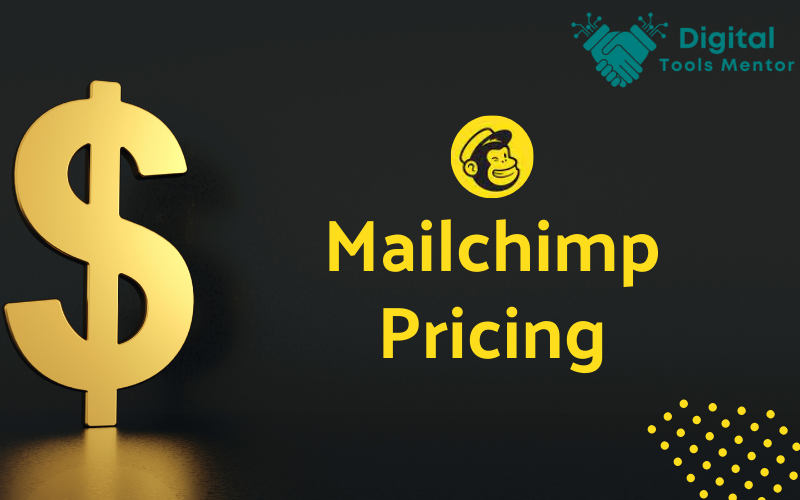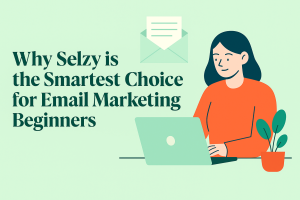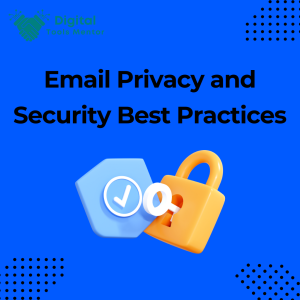Mailchimp Pricing 2025: Which Plan Do you Need?
As of 2025, Mailchimp continues to stand tall as a leading email marketing tool, renowned for its user-friendly interface, robust feature set, and flexible pricing options. Catering to a wide range of users, from small businesses and startups to large enterprises, Mailchimp has established itself as a go-to solution for anyone looking to enhance their email marketing campaigns. Its comprehensive set of tools for creating, managing, and analyzing email campaigns makes it a popular choice in the dynamic landscape of digital marketing. Understanding Mailchimp pricing structure is crucial for businesses and marketers aiming to maximize their investment in email marketing. With various plans tailored to different needs and budgets, Mailchimp offers options ranging from a basic free plan to more advanced, feature-rich paid plans. Each of these plans comes with its own set of features and limitations, making it important for users to carefully assess which plan aligns best with their marketing objectives and financial constraints.
In this guide, we will delve into the specifics of Mailchimp’s pricing as of 2025, providing a clear breakdown of what each plan offers. Whether you are just starting out with email marketing or looking to scale up your existing efforts, this overview will help you make an informed decision about which Mailchimp plan is the most suitable for your business needs. Understanding these options will not only help in budgeting effectively but also ensure that you have access to the right tools to successfully execute and manage your email marketing campaigns.
Overview of Mailchimp Pricing in 2025
In 2025, Mailchimp continues to offer a range of pricing plans designed to accommodate the varying needs of email marketers, from individuals and small businesses to large corporations. Understanding the nuances of these pricing structures is key to selecting the plan that best fits your marketing strategy and budget. Let’s explore the general pricing structure of Mailchimp in 2025 and what each tier offers.
General Overview of Mailchimp Pricing Structure
Mailchimp’s pricing is structured to scale with the size and needs of your business. In 2025, the platform typically offers several tiers, each with its own set of features and limitations:
- Free Plan: Designed for small businesses and new marketers, this plan usually includes basic email marketing features with a limitation on the number of contacts and the total number of emails you can send per month.
- Essentials Plan: This plan is a step up from the free version, offering a larger subscriber limit and access to more advanced tools like A/B testing and 24/7 email and chat support. It’s ideal for businesses that are growing and need more from their email marketing tools.
- Standard Plan: Targeting growing businesses with more sophisticated marketing needs, the Standard Plan typically includes everything in the Essentials Plan plus additional features like advanced audience insights, retargeting ads, and automation capabilities.
- Premium Plan: This is the most comprehensive plan, suitable for large businesses and enterprises. It usually offers advanced features such as multivariate testing, advanced segmentation, and phone support, along with a higher number of allowed contacts and email sends.
Mailchimp Pricing Tiers and What They Include
- Free Plan:
- Ideal for beginners and small businesses.
- Includes basic email templates, a marketing CRM, and a limited number of email sends per month.
- Subscriber limit is typically the lowest among all plans.
- Essentials Plan:
- Includes all features in the Free Plan.
- Additional features like A/B testing, custom branding, and 24/7 support.
- Higher subscriber and email send limits compared to the Free Plan.
- Standard Plan:
- Suitable for businesses with growing marketing needs.
- Includes features like advanced audience insights, behavioral targeting, and custom templates.
- Higher limits on the number of subscribers and monthly email sends.
- Premium Plan:
- Designed for large-scale businesses requiring extensive email marketing capabilities.
- Offers the highest limits on subscribers and email sends.
- Advanced features like multivariate testing, phone support, and advanced segmentation.
Each of these plans is priced differently, with costs generally increasing with the level of features and allowances provided. It’s important to note that pricing can also vary based on the number of contacts in your database, making it essential to consider both the feature set and the contact limit when choosing the right plan for your needs.
In summary, Mailchimp in 2025 offers a flexible pricing structure designed to cater to a wide range of users, from those just starting out to large enterprises with complex email marketing needs. Understanding the specifics of each plan can help you make an informed decision that aligns with your marketing objectives and budget constraints.
Mailchimp Free Plan: Features and Limitations
Mailchimp’s Free Plan in 2025 continues to be a popular choice for individuals, small businesses, and startups taking their first steps into email marketing. This plan provides a no-cost solution to explore the basics of email marketing and understand how Mailchimp can fit into your marketing strategy. Let’s delve into the specific features and limitations of the Free Plan to determine if it’s the right starting point for you.
Mailchimp’s Free Plan
- Subscriber Limit:
- The Free Plan typically includes a maximum number of subscribers or contacts. This limit is sufficient for small businesses or individuals just starting to build their email list.
- Monthly Email Sends:
- There is a cap on the number of emails you can send per month. This is usually calculated based on your subscriber count and is designed to accommodate basic email marketing needs.
- Access to Basic Email Templates:
- The plan includes access to a selection of basic email templates. These templates are customizable, allowing you to design professional-looking emails without needing advanced design skills.
- Marketing CRM:
- Access to Mailchimp’s basic Marketing CRM is included, enabling you to manage and organize your contacts effectively.
- Basic Email Automation:
- The Free Plan offers fundamental automation features, such as welcome emails, which can be a great way to start automating your email marketing efforts.
- Basic Reporting:
- You’ll have access to basic reporting features, giving insights into how your emails are performing in terms of opens, clicks, and more.
Limitations of the Free Plan Features
- Limited Features:
- Advanced features such as send-time optimization, advanced segmentation, and multivariate testing are not available in the Free Plan.
- No Access to Premium Support:
- The Free Plan does not include priority support, which means you won’t have access to 24/7 live chat or phone support.
- Branding:
- Emails sent using the Free Plan typically include Mailchimp branding. This may not be ideal for businesses looking to establish a strong, independent brand identity.
- Limited Integrations:
- The ability to integrate with other tools and platforms may be limited in the Free Plan, which could be a drawback for businesses using multiple systems.
- Scalability:
- As your business grows and your email marketing needs become more complex, you may find the limitations of the Free Plan too restrictive.
The Free Plan is an excellent way to get started with Mailchimp, offering fundamental tools and features needed to launch basic email marketing campaigns. However, as your marketing needs grow and evolve, you may need to consider upgrading to a paid plan to access more advanced features and greater flexibility. This plan is ideal for those who are new to email marketing or have a limited budget but still want to benefit from the capabilities of a professional email marketing platform.
Mailchimp Essentials Plan: For Small Businesses and Startups
Mailchimp’s Essentials Plan in 2025 is tailored for small businesses and startups looking to take their email marketing to the next level. Offering a balance between affordability and functionality, this plan is designed to cater to the needs of growing businesses that require more advanced features than the Free Plan offers. Let’s explore the Essentials Plan, its pricing, target users, and the features and limitations it includes.
Overview of the Essentials Plan, Its Price, and Its Target Users
- Target Audience:
- The Essentials Plan is ideal for small businesses and startups that have outgrown the basic functionalities of the Free Plan. It’s particularly suited for those who need more sophisticated email marketing tools but are not yet ready for the more advanced features of higher-tier plans.
- Pricing Structure:
- Pricing for the Essentials Plan typically varies based on the number of contacts in your list. The cost increases as your subscriber list grows, making it a scalable option for growing businesses.
Features, Limits, and Pricing of the Essentials Plan
- Subscriber and Email Limits:
- This plan usually offers a higher subscriber limit than the Free Plan, along with a more generous monthly email send limit. These increased limits are beneficial for businesses with growing email lists.
- Access to All Email Templates:
- Unlike the Free Plan, the Essentials Plan provides access to Mailchimp’s entire library of email templates, offering more variety and flexibility in designing your campaigns.
- Advanced Segmentation:
- The plan includes more advanced segmentation options, allowing you to target your campaigns more precisely based on subscriber data and behavior.
- A/B Testing:
- With the Essentials Plan, you get access to A/B testing capabilities, enabling you to test different versions of your emails to see what works best with your audience.
- 24/7 Email and Chat Support:
- This plan typically includes access to 24/7 email and chat support, providing more immediate assistance compared to the Free Plan.
- Custom Branding:
- The Essentials Plan allows for custom branding in your emails, enabling you to remove Mailchimp branding and reinforce your own brand identity in your communications.
- Reporting and Analytics:
- Enhanced reporting features are available, offering deeper insights into campaign performance, subscriber behavior, and engagement metrics.
- Limitations:
- While more feature-rich than the Free Plan, the Essentials Plan still has limitations compared to higher-tier plans, such as the absence of advanced automation features, multivariate testing, and certain integrations.
In summary, Mailchimp’s Essentials Plan in 2025 strikes a balance between affordability and functionality, making it an excellent choice for small businesses and startups ready to upgrade their email marketing efforts. With its expanded feature set and increased limits, the Essentials Plan offers the tools needed for more effective and targeted email marketing, while still being cost-effective for businesses in the growth phase.
Mailchimp Standard Plan: Advanced Features for Growing Businesses
Mailchimp’s Standard Plan in 2025 is designed to cater to the needs of growing businesses seeking more advanced features and capabilities in their email marketing efforts. This plan is a step up from the Essentials Plan, offering a richer set of tools and functionalities ideal for businesses with expanding marketing requirements. Let’s delve into what the Standard Plan offers, its pricing, and why it’s a great fit for growing businesses.
Mailchimp Standard Plan, Its Price, and Ideal for Growing Businesses
- Target Audience:
- The Standard Plan is tailored for businesses that have outgrown the Essentials Plan and require advanced marketing tools to manage and scale their campaigns effectively. It’s ideal for businesses with growing email lists and those who need more sophisticated targeting and analytics features.
- Pricing Structure:
- Similar to the Essentials Plan, the pricing for the Standard Plan typically depends on the number of subscribers in your email list. The plan is structured to accommodate businesses as they grow, with pricing tiers that scale according to the size of your subscriber list.
Additional Features and Pricing Tiers of the Standard Plan
- Increased Contact Limits and Email Sends:
- The Standard Plan generally offers higher contact limits and email send capacities than the Essentials Plan, catering to businesses with larger subscriber bases.
- Advanced Segmentation:
- This plan allows for more complex segmentation strategies, enabling businesses to target their audience with greater precision based on a wider range of subscriber data and behavior.
- Behavioral Targeting:
- The Standard Plan includes behavioral targeting features, allowing you to tailor your campaigns based on subscriber actions and interactions with your content, both in emails and on your website.
- Event-Based Automation:
- With this plan, you can create automation workflows triggered by specific events or subscriber actions, providing a more personalized experience for your audience.
- Retargeting Ads:
- The plan typically includes options for creating retargeting ads on various platforms, helping to integrate your email marketing efforts with your broader digital marketing strategy.
- Enhanced Reporting and Analytics:
- Expect more comprehensive analytics and reporting tools, offering deeper insights into campaign performance, audience behavior, and ROI.
- Multichannel Campaigns:
- The Standard Plan often supports the creation of multichannel campaigns, allowing you to reach your audience through multiple platforms and mediums.
- Pricing Tiers:
- The pricing for the Standard Plan varies based on the number of contacts. It’s designed to be cost-effective for businesses at different stages of growth, with the flexibility to upgrade as your subscriber list expands.
In summary, the Standard Plan from Mailchimp in 2025 is a robust option for growing businesses seeking to leverage advanced email marketing features. With its expanded capacity for contacts and emails, along with sophisticated targeting, automation, and analytics capabilities, the Standard Plan offers the tools necessary for effective and scalable email marketing campaigns. This plan is a valuable investment for businesses looking to deepen their engagement with a growing audience and achieve more nuanced marketing objectives.
Mailchimp Premium Plan: Comprehensive Solution for Large Enterprises
Mailchimp’s Premium Plan in 2025 stands as the most comprehensive solution within its suite of offerings, specifically designed to meet the complex and diverse needs of large enterprises. This plan is the epitome of advanced email marketing, offering the highest level of functionality, customization, and support. Let’s explore why the Premium Plan is particularly suited for large-scale operations and delve into its advanced features and pricing structure.
Premium Plan and Its Suitability for Large Enterprises
- Targeted Towards Large Businesses:
- The Premium Plan is tailored for large enterprises with extensive email marketing needs. It’s ideal for businesses that require advanced customization, extensive segmentation, and sophisticated automation capabilities to manage large subscriber lists and complex marketing strategies.
- Customization and Scalability:
- This plan offers the highest degree of customization and scalability. It’s designed to accommodate the large-scale and often evolving marketing demands of big enterprises, providing the tools needed to execute a wide array of sophisticated marketing tactics.
In-Depth Analysis of Advanced Features and Custom Pricing of the Premium Plan
- Advanced Segmentation Capabilities:
- The Premium Plan allows for highly advanced segmentation, enabling enterprises to target their audience with precision using a multitude of subscriber data and behavior metrics.
- Multivariate Testing:
- Unlike the lower-tier plans, the Premium Plan includes multivariate testing, allowing businesses to test multiple variables simultaneously and gain more comprehensive insights into what resonates best with their audience.
- Unlimited Email Sends:
- Enterprises can benefit from unlimited email sends, essential for businesses with vast subscriber lists and frequent communication needs.
- Advanced Automation and Personalization:
- This plan offers the most advanced automation and personalization options, including complex workflow capabilities and dynamic content options tailored to individual subscriber behavior and preferences.
- Dedicated Support:
- Premium Plan subscribers typically receive dedicated support, including priority phone support, which ensures quick and effective resolution of any issues or queries.
- Comprehensive Analytics and Reporting:
- Enhanced analytics and reporting features enable large enterprises to deeply analyze the performance of their campaigns and make data-driven decisions.
- Integrations and API Access:
- Extensive integration options and API access are available, allowing for seamless connectivity with a wide range of third-party platforms and internal systems.
- Custom Pricing:
- The pricing of the Premium Plan is usually custom-tailored to suit the specific needs of the business. The cost is typically based on factors like the size of the subscriber list and the level of customization and support required.
In conclusion, Mailchimp’s Premium Plan in 2025 is an all-encompassing solution for large enterprises looking to leverage email marketing at scale. With its advanced features, unlimited sending capabilities, and dedicated support, this plan is perfectly suited to meet the complex and varied needs of large businesses. The custom pricing model also ensures that enterprises pay for exactly what they need, making it a cost-effective solution for high-scale email marketing operations.
Comparing Mailchimp Plans: Which One is Right for You?
Choosing the right Mailchimp plan in 2025 is crucial for aligning your email marketing strategy with your business’s size and needs. Each plan – Free, Essentials, Standard, and Premium – offers distinct features and capabilities. A side-by-side comparison can help you understand the differences and make an informed decision. Let’s break down these plans and provide guidance on selecting the most suitable one for your business.
Side-by-Side Comparison of Free, Essentials, Standard, and Premium Plans
- Free Plan:
- Target Audience: Ideal for individuals or small businesses just starting out.
- Key Features: Basic email templates, marketing CRM, limited email sends.
- Limitations: Limited to basic features, lower send limits, and Mailchimp branding on emails.
- Essentials Plan:
- Target Audience: Small businesses or startups looking to expand their email marketing.
- Key Features: Access to all email templates, A/B testing, and 24/7 support.
- Limitations: Limited advanced features, higher but still capped subscriber and send limits.
- Standard Plan:
- Target Audience: Growing businesses needing more sophisticated marketing tools.
- Key Features: Advanced segmentation, behavioral targeting, custom templates.
- Limitations: More features than Essentials but lacks some of the Premium plan’s advanced capabilities.
- Premium Plan:
- Target Audience: Large enterprises with extensive email marketing requirements.
- Key Features: Advanced segmentation, multivariate testing, unlimited sends, dedicated support.
- Limitations: Higher cost, but with the most comprehensive set of features.
Guidance on Choosing the Right Plan Based on Business Size and Needs
- Assess Your Audience Size:
- Consider the size of your email list. Smaller lists may be well-served by the Free or Essentials plans, while larger lists might require the Standard or Premium plans.
- Determine Your Feature Requirements:
- Evaluate the features you need. If basic email campaigns are sufficient, the Free or Essentials plans may be adequate. For more complex automation and targeting, consider the Standard or Premium plans.
- Consider Your Budget:
- Align your plan choice with your budget. The Free plan is a great starting point with no cost, while the Premium plan, although more expensive, offers the most advanced features.
- Plan for Growth:
- If your business is growing or you anticipate growth, choose a plan that can scale with you. The Standard and Premium plans offer more scalability for growing businesses.
- Evaluate Support Needs:
- If you anticipate needing more hands-on support, the Essentials, Standard, and especially Premium plans offer more comprehensive support options.
- Marketing Goals and Strategy:
- Align the plan with your overall marketing goals and strategies. More advanced marketing strategies may require the more sophisticated features of the Standard or Premium plans.
In summary, selecting the right Mailchimp plan in 2025 requires a careful evaluation of your business size, marketing needs, audience size, budget, and growth plans. By comparing the features and limitations of each plan, you can choose a plan that not only fits your current needs but also supports your future growth and marketing ambitions. Remember, as your business evolves, you can always reassess and adjust your plan choice to continue aligning with your changing needs.
Mailchimp Pricing: Additional Costs and Considerations
While Mailchimp’s pricing plans are designed to cater to a variety of needs and budgets, it’s important to be aware of potential additional costs and considerations that could impact your overall budget and strategy. This includes understanding add-ons, overage fees, and other factors that may affect your cost when using Mailchimp. Let’s discuss these in more detail to help you budget effectively and scale your email marketing efforts with Mailchimp.
Additional Costs
- Add-Ons:
- Mailchimp offers various add-ons that can enhance your email marketing capabilities. These might include advanced automation, premium support, dedicated IP addresses, or additional analytics features.
- Each add-on typically comes with an additional cost, so it’s important to consider which, if any, are necessary for your marketing needs and to factor these into your overall budget.
- Overage Fees:
- If you exceed the limits of your plan, such as the number of emails sent or the number of contacts, you may incur overage fees.
- Understanding these fees and monitoring your usage can help avoid unexpected costs.
- Transactional Emails:
- If you’re using Mailchimp for transactional emails (like order confirmations or shipping notices), there might be additional costs associated with these emails, especially if they are beyond the scope of your chosen plan.
- Integrations:
- While many integrations are free, some third-party integrations might require a subscription or one-time purchase.
- Evaluate the costs of these integrations and how they contribute to your overall email marketing strategy.
Considerations for Budgeting and Scaling with Mailchimp
- Forecasting Growth:
- Anticipate the growth of your email list and how that might move you into a higher pricing tier. Factor in potential plan upgrades in your budget planning.
- Consider how your email marketing strategy might evolve and whether you’ll need more advanced features in the future.
- Evaluating ROI:
- Regularly assess the return on investment (ROI) of your email campaigns. This includes considering the costs of your Mailchimp plan and any add-ons against the revenue generated or other value provided by your email marketing efforts.
- Cost-Benefit Analysis of Features:
- Evaluate whether the additional features of higher-tier plans will meaningfully contribute to your marketing goals. Sometimes, less expensive plans with fewer features can be more cost-effective for certain businesses.
- Flexibility and Scalability:
- Consider how easily you can scale up or down based on your business’s performance and needs. Being able to adjust your plan or add-ons provides flexibility and can be more cost-effective.
- Budget Allocation:
- Allocate your marketing budget in a way that maximizes the efficiency and effectiveness of your email marketing. This might involve balancing spending on Mailchimp with other marketing channels and tools.
In conclusion, while Mailchimp offers flexible pricing plans, being aware of potential additional costs and strategically planning your budget are crucial steps in maximizing the effectiveness of your email marketing. By carefully considering these additional costs and how they align with your business goals and growth trajectory, you can make more informed decisions and optimize your use of Mailchimp for the best possible outcomes.
Tips for Maximizing Value with Mailchimp
Leveraging Mailchimp effectively can significantly enhance your email marketing campaigns, regardless of the plan you choose. To get the most out of your Mailchimp subscription, it’s important to employ strategies that maximize the platform’s capabilities. Here are some tips and strategies for optimizing your email marketing efforts within Mailchimp’s framework, ensuring you derive maximum value from your chosen plan.
Strategies to Get the Most Out of Your Chosen Mailchimp Plan
- Utilize All Available Features:
- Make sure you are aware of and using all the features available in your Mailchimp plan. This includes not only the basic functionalities like email creation and list management but also advanced features like segmentation, A/B testing, and analytics.
- Regularly Clean and Update Your Email List:
- Regular list maintenance is crucial for keeping your campaigns effective. Remove inactive subscribers and regularly update your list to ensure your emails are being sent to engaged and interested recipients.
- Personalize Your Emails:
- Use the data you have on your subscribers to personalize your emails. Even simple personalization, like using a subscriber’s name, can significantly increase open and click-through rates.
- Implement Automated Campaigns:
- Set up automated email campaigns for welcome series, follow-ups, or re-engagement. Automation saves time and can lead to more consistent engagement with your audience.
- Segment Your Audience:
- Use segmentation to tailor your emails to different parts of your audience. This can lead to higher engagement as your messages will be more relevant to each segment’s interests and needs.
Tips on Optimizing Email Marketing Strategies Within Mailchimp’s Framework
- Test and Optimize Your Emails:
- Regularly perform A/B testing on various aspects of your emails, such as subject lines, content, and send times, to find out what works best with your audience.
- Use Analytics to Inform Strategy:
- Pay close attention to the analytics provided by Mailchimp. Use these insights to understand subscriber behavior and preferences, and adjust your strategy accordingly.
- Explore Integrations:
- Integrate Mailchimp with other tools you use, such as CRM systems or e-commerce platforms. This can help streamline your marketing efforts and provide a more cohesive customer experience.
- Stay Updated with New Features and Best Practices:
- Mailchimp regularly updates its platform with new features. Stay informed about these updates and continually educate yourself on email marketing best practices.
- Engage with Mailchimp’s Resources:
- Utilize Mailchimp’s vast array of educational resources, like tutorials, webinars, and guides. These can provide valuable insights and tips for enhancing your email marketing.
- Optimize for Mobile:
- With a significant portion of emails being opened on mobile devices, ensure your emails are mobile-friendly with responsive designs.
In summary, maximizing value with Mailchimp involves a combination of utilizing the full range of features available in your plan, maintaining and segmenting your email list effectively, and continuously testing and refining your strategy based on performance analytics. By following these tips and staying engaged with the platform’s developments, you can create more effective, personalized, and impactful email marketing campaigns that resonate with your audience and meet your business goals.
Mailchimp Pricing: Conclusion
In 2025, Mailchimp continues to offer a versatile range of pricing options, catering to a wide spectrum of email marketing needs. From the no-cost Free Plan for beginners and small-scale marketers to the comprehensive Premium Plan for large enterprises, Mailchimp provides solutions for every stage of business growth. This guide has explored each of these plans – Free, Essentials, Standard, and Premium – detailing their features, limitations, and ideal user profiles to help you make an informed decision.
When selecting the best Mailchimp plan for your marketing objectives, consider factors such as the size of your email list, the complexity of your marketing strategies, and the specific features you need. Remember, the right plan should not only fit your current needs but also have the capacity to scale as your business grows. Whether you’re just starting out or looking to expand your reach, Mailchimp offers the tools and flexibility to support your journey in email marketing.
In conclusion, understanding Mailchimp’s pricing structure and the nuances of each plan is key to leveraging the platform’s full potential. By aligning your choice with your marketing goals and budget, you can maximize the effectiveness of your campaigns and ensure a solid return on your email marketing investment.




